DIY e-bike from 2006
UPDATE
****** I built this bike back in 2006 to get to univerity and back. I've built many different types of other e-bikes since, some of them are documented on this website too. ******
This is an OLD page now, here as a historic reference.
For up to date information about my work repairing e-bikes please go back to the main menu and click on the Electric bike link.
Thanks
This was an absolute joy to ride, it could be used just like a normal bike, or as an electric vehicle with a cruising speed of 30-35km/h (top speed 40km/h !!)
2007 was early in e-bike development and this e-bike used HEAVY lead acid batteries, the modern e-bikes use migh lighter and much more envinonmentally friendly lithium batteries.
Essentially it's a hybrid vehicle without the big $$ price tag.

Please excuse the shabby photo, I had just put it together, taped the wires in place and just had to ride it, don't worry, I tidied up the birds nest of wiring shortly after !
UPDATE
2008 - I've now done more than 4600km on my homemade E-Bike,
it's an awesome commuter,
I can do almost all of my shopping on the bike and have invested in a 1.2W solar panel to charge my car's battery because I hardly use it now :)
2008 - I've now done more than 4600km on my homemade E-Bike,
it's an awesome commuter,
I can do almost all of my shopping on the bike and have invested in a 1.2W solar panel to charge my car's battery because I hardly use it now :)
You will need to buy a motor, and controller, and then batteries.
I recommend buying a kit, unless you have the technical knowledge, and time to buy the parts individually.
Most kits come with a pre-spoked rim, and everything is designed to just bolt onto the bike.
I choose to do things myself, firstly to save costs, but also because I really enjoy the whole process from initial research and design through to completing the project
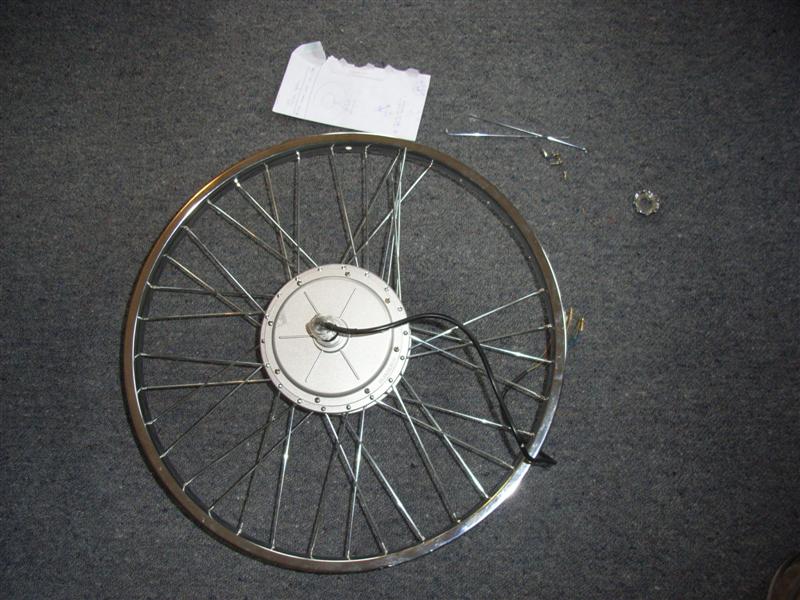
One of the difficult parts, and probably the most time consuming was spoking the hub motor into the rim. This is best done in the lounge, with the TV turned off!
If you don't want to do this yourself, your local bike shop will do it for you in less than an hour.
If you don't want to do this yourself, your local bike shop will do it for you in less than an hour.
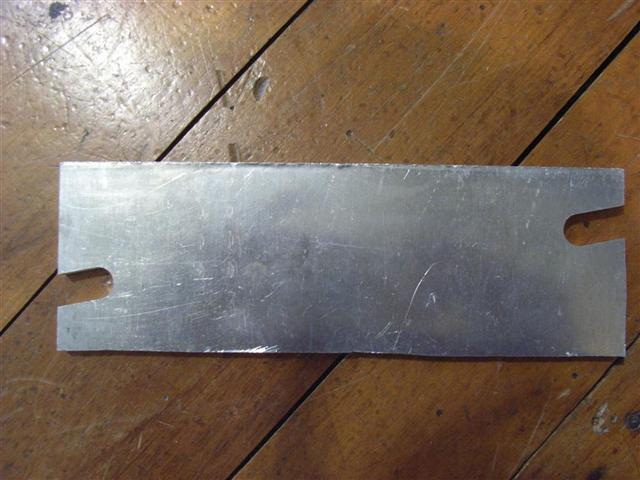
The axel needs to be held firmly in place. This is to stop the torque from the motor spinning the axle and ruining the bike frame, I'm making a torque plate. This photo shows the aluminum plate after routing.
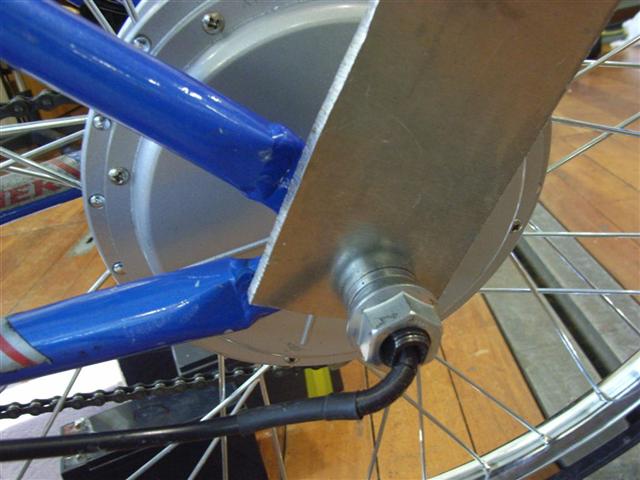
Visual checking, before trimming and tidying up.
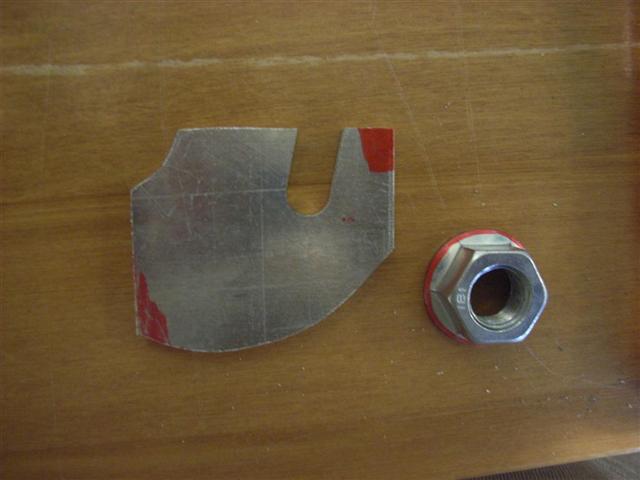
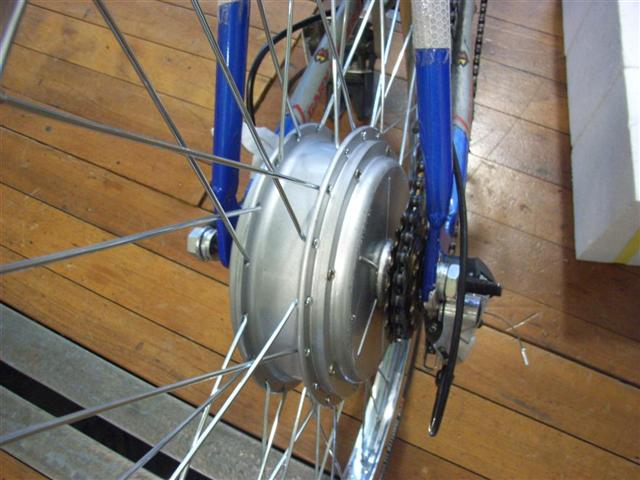
Because of the width of the motor, only 3 gears are used on the back wheel. This was actually plenty, because the city I was living in was flat and the motor hadi loads of torque.

The working prototype after fitting the toolbox to hold the batteries. I just couldn't wait to ride it !
It's such a joy to ride !!!
If you want more info, send me an e-mail.
Or if you live in Christchurch, get in touch and come and have a ride, you'l never go back to fossil fuels !
My Electric Bike's fuel economy
My e-bike has a range of about 45km, at a speed of 20 - 25km/h.
Now considering that it takes ~5cents of electricity to fully charge it up, that's an amazing 9km/cent!!
Now multiply that by the cost of a litre of petrol,
9* 150 cents = 1350 km / litre !!!!!!
Now maybe you understand why i love my bike :)
9* 150 cents = 1350 km / litre !!!!!!
Now maybe you understand why i love my bike :)
How to make your own Electric Bike
I used a "GL1 Hub Motor Kit" that I bought over the web from Brett White. This consists of a 650W brushless gearless DC motor and the controller (with regenerative braking) and the twist grip throttle.NB that is mechanical power at the back wheel, ie almost 1 horse power(which is about 3 human power!!)
Also included are extra strength spokes, to handle the 5.8 kg weight of the motor and of course the extra torque it produces.
The Batteries were I chose were $200 for four 12v 9Ahr lead acid batteries. These were wired in series to give 48v(the higher the voltage the better as this minimises any resistive line losses)
They give me a range of about 45 km traveling about 20-25kmph (with me peddling gently)
These batteries are special "AGM" sealed lead acid batteries, designed to handle the high discharge currents that is typical of an electric vehicle.
I can blast along at up to 40kph, but the batteries will not propel me nearly as far at such high current drainage due to the Peukert effect.
"The Peukert law becomes a key issue in a battery electric vehicle where batteries rated at 20 hour discharges are used at much greater rates of about 1 hour." www.wikipedia/Peukert's_law
Basically this means the faster you discharge a lead acid battery, you get less and less energy out of it.
This all comes down to the chemistry of the cells, and the fact that their capacity is calculated at a gentle discharge rate spread over 20hrs.
The type and amount of batteries that you need will depend on how far you want to travel, how much weight you are prepared to carry and of course how much money you have to spend.
Need help making your electric bike?
There is lots of information out there on the web, but I have found the following site to be very accurate and reliable.ebikes.ca "Thinking Outside the Four-Wheeled Box"
No time to make your own electric bike?
Contact me via the contact page on my web site.Selling and servicing e-bikes and doing electronics design and repair for the Department of Conservation are my main jobs these days.
Copyright 1997-2018 by Anthony Field on all images/text/information and graphical materials on this website.